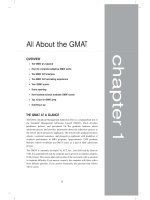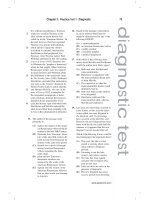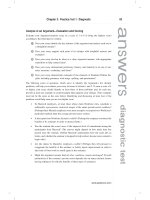Master gmat 2010 part 8 ppsx
Bạn đang xem bản rút gọn của tài liệu. Xem và tải ngay bản đầy đủ của tài liệu tại đây (90.54 KB, 10 trang )
ANSWER SHEET PRACTICE TEST 1: DIAGNOSTIC
ANALYTICAL WRITING ASSESSMENT
Analysis of an Issue
✁
answer sheet
Chapter 3: Practice Test 1: Diagnostic 53
www.petersons.com
✁
54 PART II: Diagnosing Strengths and Weaknesses
www.petersons.com
Analysis of an Argument
✁
answer sheet
Chapter 3: Practice Test 1: Diagnostic 55
www.petersons.com
✁
56 PART II: Diagnosing Strengths and Weaknesses
www.petersons.com
QUANTITATIVE SECTION
1. O
A
O
B
O
C
O
D
O
E
2. O
A
O
B
O
C
O
D
O
E
3. O
A
O
B
O
C
O
D
O
E
4. O
A
O
B
O
C
O
D
O
E
5. O
A
O
B
O
C
O
D
O
E
6. O
A
O
B
O
C
O
D
O
E
7. O
A
O
B
O
C
O
D
O
E
8. O
A
O
B
O
C
O
D
O
E
9. O
A
O
B
O
C
O
D
O
E
10. O
A
O
B
O
C
O
D
O
E
11. O
A
O
B
O
C
O
D
O
E
12. O
A
O
B
O
C
O
D
O
E
13. O
A
O
B
O
C
O
D
O
E
14. O
A
O
B
O
C
O
D
O
E
15. O
A
O
B
O
C
O
D
O
E
16. O
A
O
B
O
C
O
D
O
E
17. O
A
O
B
O
C
O
D
O
E
18. O
A
O
B
O
C
O
D
O
E
19. O
A
O
B
O
C
O
D
O
E
20. O
A
O
B
O
C
O
D
O
E
21. O
A
O
B
O
C
O
D
O
E
22. O
A
O
B
O
C
O
D
O
E
23. O
A
O
B
O
C
O
D
O
E
24. O
A
O
B
O
C
O
D
O
E
25. O
A
O
B
O
C
O
D
O
E
26. O
A
O
B
O
C
O
D
O
E
27. O
A
O
B
O
C
O
D
O
E
28. O
A
O
B
O
C
O
D
O
E
29. O
A
O
B
O
C
O
D
O
E
30. O
A
O
B
O
C
O
D
O
E
31. O
A
O
B
O
C
O
D
O
E
32. O
A
O
B
O
C
O
D
O
E
33. O
A
O
B
O
C
O
D
O
E
34. O
A
O
B
O
C
O
D
O
E
35. O
A
O
B
O
C
O
D
O
E
36. O
A
O
B
O
C
O
D
O
E
37. O
A
O
B
O
C
O
D
O
E
VERBAL SECTION
1. O
A
O
B
O
C
O
D
O
E
2. O
A
O
B
O
C
O
D
O
E
3. O
A
O
B
O
C
O
D
O
E
4. O
A
O
B
O
C
O
D
O
E
5. O
A
O
B
O
C
O
D
O
E
6. O
A
O
B
O
C
O
D
O
E
7. O
A
O
B
O
C
O
D
O
E
8. O
A
O
B
O
C
O
D
O
E
9. O
A
O
B
O
C
O
D
O
E
10. O
A
O
B
O
C
O
D
O
E
11. O
A
O
B
O
C
O
D
O
E
12. O
A
O
B
O
C
O
D
O
E
13. O
A
O
B
O
C
O
D
O
E
14. O
A
O
B
O
C
O
D
O
E
15. O
A
O
B
O
C
O
D
O
E
16. O
A
O
B
O
C
O
D
O
E
17. O
A
O
B
O
C
O
D
O
E
18. O
A
O
B
O
C
O
D
O
E
19. O
A
O
B
O
C
O
D
O
E
20. O
A
O
B
O
C
O
D
O
E
21. O
A
O
B
O
C
O
D
O
E
22. O
A
O
B
O
C
O
D
O
E
23. O
A
O
B
O
C
O
D
O
E
24. O
A
O
B
O
C
O
D
O
E
25. O
A
O
B
O
C
O
D
O
E
26. O
A
O
B
O
C
O
D
O
E
27. O
A
O
B
O
C
O
D
O
E
28. O
A
O
B
O
C
O
D
O
E
29. O
A
O
B
O
C
O
D
O
E
30. O
A
O
B
O
C
O
D
O
E
31. O
A
O
B
O
C
O
D
O
E
32. O
A
O
B
O
C
O
D
O
E
33. O
A
O
B
O
C
O
D
O
E
34. O
A
O
B
O
C
O
D
O
E
35. O
A
O
B
O
C
O
D
O
E
36. O
A
O
B
O
C
O
D
O
E
37. O
A
O
B
O
C
O
D
O
E
38. O
A
O
B
O
C
O
D
O
E
39. O
A
O
B
O
C
O
D
O
E
40. O
A
O
B
O
C
O
D
O
E
41. O
A
O
B
O
C
O
D
O
E
✁
answer sheet
Chapter 3: Practice Test 1: Diagnostic 57
www.petersons.com
Practice Test 1:
Diagnostic
ANALYTICAL WRITING ASSESSMENT
Analysis of an Issue
1 QUESTION • 30 MINUTES
Directions: Using a word processor, compose a response to the
following statement and directive. Do not use any spell-checking or
grammar-checking functions.
“As adults we prefer to define ourselves more by our occupation
than by our affiliation with social groups.”
In your view, how accurate is the foregoing statement? Use reasons
and/or examples from your experience, observation, and/or reading to
explain your viewpoint.
practice test 1
59
Analysis of an Argument
1 QUESTION • 30 MINUTES
Directions: Using a word processor, compose an essay for the following argument and
directive. Do not use any spell-checking or grammar-checking functions.
The following appeared as part of an article in a national business publication:
“Workforce Systems, a consulting firm specializing in workplace productivity and
efficiency, reports that nearly 70 percent of Maxtech’s employees who enrolled in
Workforce Systems’ one-week seminar last year claim to be more content with their
current jobs than prior to enrolling in the seminar. By requiring managers at all
large corporations to enroll in the kinds of seminars that Workforce System offers,
productivity in our economy’s private sector is certain to improve.”
Discuss how well reasoned you find this argument. In your discussion, be sure to
analyze the line of reasoning and the use of evidence in the argument. For example, you
may need to consider what questionable assumptions underlie the thinking and what
alternative explanations or counterexamples might weaken the conclusion. You can also
discuss what sort of evidence would strengthen or refute the argument, what changes in
the argument would make it more logically sound, and what, if anything, would help
you better evaluate its conclusion.
60 PART II: Diagnosing Strengths and Weaknesses
www.petersons.com
QUANTITATIVE SECTION
37 QUESTIONS • 75 MINUTES
Directions for Problem Solving Questions: (These directions will appear on your
screen before your first Problem Solving question.)
Solve this problem and indicate the best of the answer choices given.
Numbers: All numbers used are real numbers.
Figures: A figure accompanying a Problem Solving question is intended to provide infor-
mation useful in solving the problem. Figures are drawn as accurately as possible EXCEPT
when it is stated in a specific problem that its figure is not drawn to scale. Straight lines
may sometimes appear jagged. All figures lie on a plane unless otherwise indicated.
To review these directions for subsequent questions of this type, click on HELP.
Directions for Data Sufficiency Questions: (These directions will appear on your
screen before your first Data Sufficiency question.)
This Data Sufficiency problem consists of a question and two statements, labeled (1) and
(2), in which certain data are given. You have to decide whether the data given in the
statements are sufficient for answering the question. Using the data given in the
statements plus your knowledge of mathematics and everyday facts (such as the
number of days in July or the meaning of counterclockwise), you must indicate whether:
(A) Statement (1) ALONE is sufficient, but statement (2) alone is not sufficient to
answer the question asked;
(B) Statement (2) ALONE is sufficient, but statement (1) alone is not sufficient to
answer the question asked;
(C) BOTH statements (1) and (2) TOGETHER are sufficient to answer the
question asked, but NEITHER statement ALONE is sufficient;
(D) EACH statement ALONE is sufficient to answer the question asked;
(E) Statements (1) and (2) TOGETHER are NOT sufficient to answer the question
asked, and additional data specific to the problem are needed.
Numbers: All numbers used are real numbers.
Figures: A figure accompanying a Data Sufficiency problem will conform to the
information given in the question, but will not necessarily conform to the additional
information in statements (1) and (2).
Lines shown as straight can be assumed to be straight and lines that appear jagged can
also be assumed to be straight.
You may assume that positions of points, angles, regions, etc., exist in the order shown
and that angle measures are greater than zero.
All figures lie in a plane unless otherwise indicated.
Note: In Data Sufficiency problems that ask you for the value of a quantity, the data
given in the statements are sufficient only when it is possible to determine exactly one
numerical value for the quantity.
To review these directions for subsequent questions of this type, click on HELP.
diagnostic test
Chapter 3: Practice Test 1: Diagnostic 61
www.petersons.com
1.
4
1
2
1 3
3
4
2 2
2
5
5
(A)
29
5
(B)
23
4
(C)
117
20
(D)
231
40
(E)
57
10
2. Lyle’s current age is 23 years, and
Melanie’s current age is 15 years.
How many years ago was Lyle’s age
twice Melanie’s age?
(A) 5
(B) 7
(C) 8
(D) 9
(E) 16
3. If x and y are integers, is x 1 y 2 1
divisible by 3?
(1) When x is divided by 3, the
remainder is 2.
(2) When y is divided by 6, the
remainder is 5.
4. Four knots—A, B, C, and D—appear
in that order along a straight length
of rope. Is the distance between B
and D the same as the distance
between A and B?
(1) The distance between A and C is
less than the distance between
B and D.
(2) Half the distance between A and
D is the same as the distance
between C and D.
5. Is x . y ?
(1) x is the arithmetic mean of all
two-digit prime numbers less
than 23.
(2) y is the sum of all factors of 60
that are greater than 21 but less
than 6.
6. In a boat race between David and
Jeff, when Jeff had covered half the
30-mile race distance, David was 2
miles ahead of Jeff. How long did it
take David to travel the entire
30-mile distance?
(1) David traveled the last 15 miles
of the race’s distance in 40
minutes.
(2) Jeff traveled the first 15 miles of
the race’s distance in 45 minutes.
7.
According to the chart shown above,
during the year that Country X’s
exports exceeded its own imports by
the greatest dollar amount, Country
Y’s imports exceeded Country X’s
imports by approximately
(A) $23 billion.
(B) $75 billion.
(C) $90 billion.
(D) $110 billion.
(E) $160 billion.
62 PART II: Diagnosing Strengths and Weaknesses
www.petersons.com









